1. Introduction: Eight things to know about glycolysis
Glycolysis is the first phase of cellular respiration: the process by which cells convert the energy in food into the energy of ATP.
I’ve written a song that covers glycolysis in about the same level of detail you’ll learn about below. You might want to view it before doing this tutorial, or afterward. Here’s the link.
If you only had a minute to learn about glycolysis, you could learn it by studying the diagram below, and then filling in the blanks below. Note that you probably will have needed to have mastered the material in the previous tutorial first.
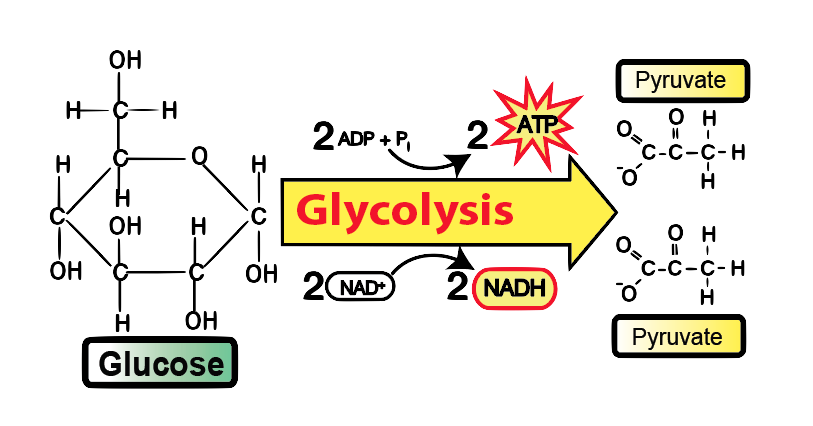
[qwiz qrecord_id=”sciencemusicvideosMeister1961-Eight Things to Know about Glycolysis Matching (M10)”]
[h]Eight things to know about glycolysis
[i]
[q labels = “top”]
1. Glycolysis is the _______ stage of cellular respiration.
2. It occurs in the cell’s _____________.
3. Glucose, a molecule with _____ carbons, is the starting compound.
4. Glycolysis means “__________ sugar.” During glycolysis, glucose gets split apart into two ______-carbon molecules.
5. The process involves _______ reactions that power the reduction of the mobile _________ carrier ______ into ______.
6. The chemical energy in glucose is also used to power two
_____________ -level phosphorylations, resulting in the production of two molecules of _________.
7. The net yield is production of _____ molecules of ATP, and two molecules of _________.
8. In addition to ATP and NADH, the final product of glycolysis is two molecules of _________ acid, also known as _________. This molecule contains ________ carbon atoms,
and still has plenty of potential ____________ energy to power the next stages of cellular respiration.
[l]ATP
[fx] No, that’s not correct. Please try again.
[f*] Great!
[l]chemical
[fx] No, that’s not correct. Please try again.
[f*] Excellent!
[l]cytoplasm
[fx] No, that’s not correct. Please try again.
[f*] Great!
[l]electron
[fx] No, that’s not correct. Please try again.
[f*] Good!
[l]first
[fx] No. Please try again.
[f*] Correct!
[l]NAD+
[fx] No. Please try again.
[f*] Excellent!
[l]NADH
[fx] No. Please try again.
[f*] Correct!
[l]pyruvate
[fx] No. Please try again.
[f*] Correct!
[l]pyruvic
[fx] No, that’s not correct. Please try again.
[f*] Great!
[l]redox
[fx] No, that’s not correct. Please try again.
[f*] Correct!
[l]six
[fx] No, that’s not correct. Please try again.
[f*] Good!
[l]splitting
[fx] No. Please try again.
[f*] Good!
[l]substrate
[fx] No, that’s not correct. Please try again.
[f*] Excellent!
[l]three
[fx] No. Please try again.
[f*] Good!
[l]two
[fx] No. Please try again.
[f*] Great!
[q]Glycolysis is the first stage of cellular [hangman]. It occurs in the cell’s [hangman]
[c]cmVzcGlyYXRpb24=[Qq]
[c]Y3l0b3BsYXNt[Qq]
[q]The net yield of glycolysis is two molecules of [hangman], which is a molecule that can immediately be used for cellular work. The other product is the electron carrier [hangman]
[c]QVRQ[Qq]
[c]TkFESA==[Qq]
[q]Glycolysis means [hangman] sugar.
[c]c3BsaXR0aW5n[Qq]
[/qwiz]
2. Glycolysis: A bit more detail
Let’s walk through the process in a bit more detail. In the diagram below, every arrow represents a chemical reaction catalyzed by a specific enzyme. Note that what’s below (however complex it might look) is still highly simplified. You can read about the details in the glycolysis article on Wikipedia, or, of course, in your textbook.
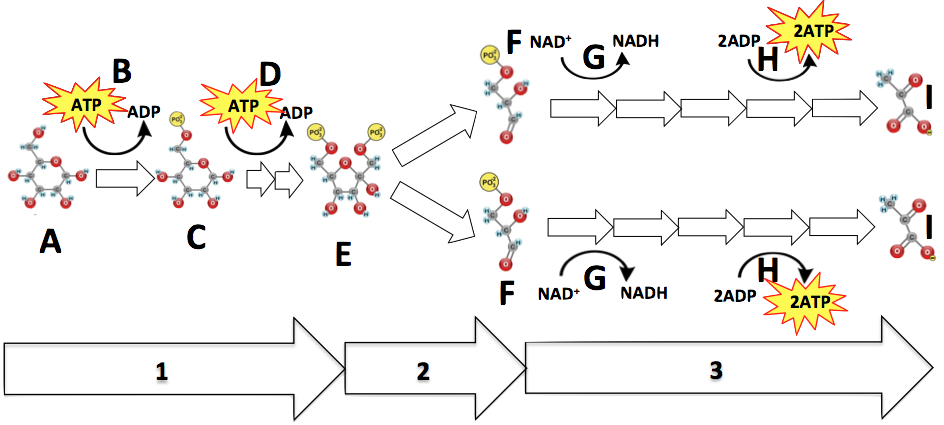
The reactions of glycolysis can be organized into three phases.
2a. Phase 1 is the investment phase.
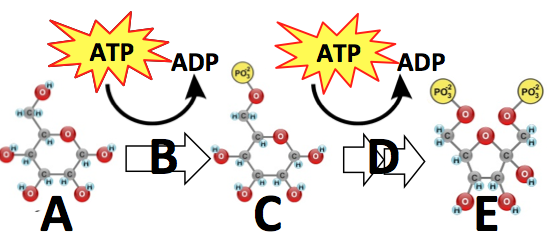
Glucose (“A”) enters glycolysis. Enzymes (indicated by arrows) phosphorylate glucose (giving it a phosphate) by removing a phosphate group from ATP (shown above “B”), which becomes ADP. The new compound at “C” is called glucose-6-phosphate: a glucose with a phosphate attached to its sixth carbon. In later reactions (shown at “D”), enzymes rearrange glucose-6-phosphate to fructose, and add another phosphate group, creating fructose-1-6-diphosphate (“E”). This costs the cell a second ATP (shown becoming ADP above “D”). This investment sets the stage for the next two phases.
2b. Phase Two is Cleavage
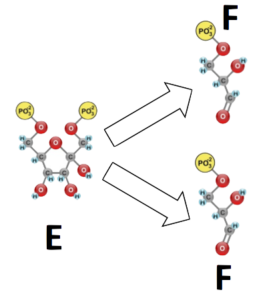 Fructose-1-6-diphosphate (“E”) is the substrate for enzymes which, in the next phase, break this six-carbon molecule into two three-carbon molecules. A bit of enzymatic interconversion (not shown) leaves us with two molecules of glyceraldehyde-3-phosphate, or G3P, shown at “F.”
Fructose-1-6-diphosphate (“E”) is the substrate for enzymes which, in the next phase, break this six-carbon molecule into two three-carbon molecules. A bit of enzymatic interconversion (not shown) leaves us with two molecules of glyceraldehyde-3-phosphate, or G3P, shown at “F.”
2c. Phase Three is Energy Harvest
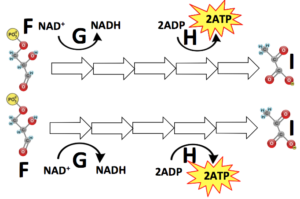 During this third and last phase of glycolysis, enzymes harvest energy from G3P (“F”), the three-carbon molecule which resulted from splitting fructose-1-6-diphosphate during the cleavage phase. At “G” enzymes oxidize G3P, and transfer electrons and hydrogen atoms to NAD+, which reduces NAD+ to NADH. NADH, you’ll remember, is a mobile electron carrier. Later in glycolysis, it will carry electrons over to the electron transport chain, which is where most of the ATP in cellular respiration is created. Other enzymes will continue to rearrange G3P in ways that enable this molecule (and the molecules it gets made into) to power two substrate-level phosphorylations, creating ATP from ADP.
During this third and last phase of glycolysis, enzymes harvest energy from G3P (“F”), the three-carbon molecule which resulted from splitting fructose-1-6-diphosphate during the cleavage phase. At “G” enzymes oxidize G3P, and transfer electrons and hydrogen atoms to NAD+, which reduces NAD+ to NADH. NADH, you’ll remember, is a mobile electron carrier. Later in glycolysis, it will carry electrons over to the electron transport chain, which is where most of the ATP in cellular respiration is created. Other enzymes will continue to rearrange G3P in ways that enable this molecule (and the molecules it gets made into) to power two substrate-level phosphorylations, creating ATP from ADP.
At the end of this harvest, we’re left with a three-carbon compound called pyruvic acid, or pyruvate (shown at “I”). Despite all of the oxidations and rearrangements that have occurred along the way, pyruvic acid still has lots of potential chemical energy, which will be harvested in later phases of cellular respiration.
3. Glycolysis: Checking Understanding
[qwiz random=”true” qrecord_id=”sciencemusicvideosMeister1961-Glycolysis: Checking Understanding (M10)”]
[h]Glycolysis: Checking Understanding
[i]
[q]Which letter or number indicates the “investment” phase?
[textentry single_char=”true”]
[c]ID E=[Qq]
[f]IFllcywg4oCcMeKAnSBpcyB0aGUgaW52ZXN0bWVudCBwaGFzZS4=[Qq]
[c]Kg==[Qq]
[f]Tm8uIEhlcmUmIzgyMTc7cyBhIGhpbnQuwqBUaGUgaW52ZXN0bWVudCBwaGFzZSBpcyB3aGVuIGVuZXJneSBpcyB1c2VkIGJ5IHRoZSBjZWxsLiBBIHR5cGljYWwgd2F5IHRoaW5nIHRoYXQgaGFwcGVucyB3aGVuIGNlbGxzIHVzZSBlbmVyZ3kgaXMgdGhhdCBBVFAgZ2V0cyBjb252ZXJ0ZWQgdG8gQURQLiBXaGVyZSBkbyB5b3Ugc2VlIHRoaXMgaGFwcGVuaW5nPw==
Cg==[Qq]
[q]Which letter or number indicates the “cleavage” phase?
[textentry single_char=”true”]
[c]wq Ay[Qq]
[f]IFllcywg4oCcMuKAnSBpcyB0aGUgY2xlYXZhZ2XCoHBoYXNlLg==[Qq]
[c]Kg==[Qq]
[f]Tm8uIEhlcmUmIzgyMTc7cyBhIGhpbnQuIFRoZSBjbGVhdmFnZSBwaGFzZSBpcyB3aGVuIG9uZSBvZiB0aGUgZ2x1Y29zZS1kZXJpdmVkIGNvbXBvdW5kcyBnZXRzIHNwbGl0IGFwYXJ0LiBXaGVyZSBkbyB5b3Ugc2VlIGEgc2l4LWNhcmJvbiBtb2xlY3VsZSBnZXQgc3BsaXQgYXBhcnQgaW50byB0d28sIDMtY2FyYm9uIG1vbGVjdWxlcz8=
Cg==[Qq]
[q]Which letter or number indicates the “harvest” phase?
[textentry single_char=”true”]
[c]wq Az[Qq]
[f]IFllcywg4oCcM+KAnSBpcyB0aGUgaGFydmVzdMKgcGhhc2Uu[Qq]
[c]Kg==[Qq]
[f]Tm8uIEhlcmUmIzgyMTc7cyBhIGhpbnQuwqBUaGUgaGFydmVzdMKgcGhhc2UgaXMgd2hlbiBlbmVyZ3kgaXPCoGFjcXVpcmVkIGJ5IHRoZSBjZWxsLiBMb29rIGZvciB3aGVyZSBBVFAgb3IgTkFESCBpcyBiZWluZyBmb3JtZWQsIGFuZCB0aGF0JiM4MjE3O3MgdGhlIGhhcnZlc3QgcGhhc2Uu
Cg==[Qq]
[q]Which letter indicates the step where glucose is first phosphorylated?
[textentry single_char=”true”]
[c]wq BC[Qq]
[f]IFllcywg4oCcQuKAnSBpcyB3aGVyZSBnbHVjb3NlIGlzIHBob3NwaG9yeWxhdGVkLCBiZWNvbWluZyBnbHVjb3NlLTYtcGhvc3BoYXRlLg==[Qq]
[c]Kg==[Qq]
[f]Tm8uIEhlcmUmIzgyMTc7cyBhIGhpbnQuIEZpbmQgYSBzdGVwIHdoZXJlIGdsdWNvc2UgaXMgZ2FpbmluZyBhIHBob3NwaGF0ZSwgYW5kIEFUUCBpcyBsb3NpbmcgYSBwaG9zcGhhdGUu
Cg==[Qq]
[q]Which letter indicates the step where glucose-6-phosphate is rearranged and phosphorylated, becoming fructose-1-6-bisphosphate?
[textentry single_char=”true”]
[c]wq BE[Qq]
[f]IFllcywg4oCcROKAnSBpcyB3aGVyZSBnbHVjb3NlLTYtcGhvc3BoYXRlIGlzIHJlYXJyYW5nZWQgYW5kIHBob3NwaG9yeWxhdGVkLCBiZWNvbWluZyBmcnVjdG9zZS0xLTYtYmlzcGhvc3BoYXRlLg==[Qq]
[c]Kg==[Qq]
[f]Tm8uIEhlcmUmIzgyMTc7cyBhIGhpbnQuIEZpbmQgYSBzdGVwIHdoZXJlIGEgc2l4LWNhcmJvbiBtb2xlY3VsZSB3aXRoIG9uZSBwaG9zcGhhdGUgaXMgcmVhcnJhbmdlZCBhbmQgYmVjb21lcyBhIHNpeC1jYXJib24gbW9sZWN1bGUgd2l0aCB0d28gcGhvc3BoYXRlcy4=
Cg==[Qq]
[q]Which letter indicates glucose-6-phosphate?
[textentry single_char=”true”]
[c]wq BD[Qq]
[f]IFllcywg4oCcQ+KAnSBpbmRpY2F0ZXMgZ2x1Y29zZS02LXBob3NwaGF0ZS4=[Qq]
[c]Kg==[Qq]
[f]Tm8uIEhlcmUmIzgyMTc7cyBhIGhpbnQuIEZpbmQgYSBzaXgtY2FyYm9uIG1vbGVjdWxlIHdpdGggb25lIHBob3NwaGF0ZSBhdHRhY2hlZC4=
Cg==[Qq]
[q]Which letter indicates fructose-1-6-bisphosphate?
[textentry single_char=”true”]
[c]wq BF[Qq]
[f]IFllcywg4oCcReKAnSBpbmRpY2F0ZXMgZnJ1Y3Rvc2UtMS02LWJpc3Bob3NwaGF0ZS4=[Qq]
[c]Kg==[Qq]
[f]Tm8uIFRoaW5rIGFib3V0IHRoZSBuYW1lIG9mIHRoZSBjb21wb3VuZCBmcnVjdG9zZS0xLTYtYmlzcGhvc3BoYXRlLiBCaXNwaG9zcGhhdGUgbWVhbnMgdHdvIHBob3NwaGF0ZXMsIHNvIGxvb2sgZm9yIGEgc2l4LWNhcmJvbiBjb21wb3VuZCB3aXRoIHR3byBwaG9zcGhhdGVzIGF0dGFjaGVkLg==
Cg==[Qq]
[q]Which letter indicates glyceraldehyde-3-phosphate (G3P)?
[textentry single_char=”true”]
[c]wq BG[Qq]
[f]IFllcywg4oCcRuKAnSBpcyBnbHljZXJhbGRlaHlkZS0zLXBob3NwaGF0ZS4=[Qq]
[c]Kg==[Qq]
[f]Tm8uIEhlcmUmIzgyMTc7cyBhIGhpbnQuIEZpbmQgYSB0aHJlZS1jYXJib24gbW9sZWN1bGUgd2l0aCBhIHNpbmdsZSBwaG9zcGhhdGUgZ3JvdXAgYXR0YWNoZWQu
Cg==[Qq]
[q]Which letter indicates a step where G3P is oxidized?
[textentry single_char=”true”]
[c]wq BH[Qq]
[f]IFllcywg4oCcR+KAnSBpcyBzaG93aW5nIHRoZSBveGlkYXRpb24gb2YgZ2x5Y2VyYWxkZWh5ZGUtMy1waG9zcGhhdGUsIHdpdGggdGhlIHNpbXVsdGFuZW91cyByZWR1Y3Rpb24gb2YgTkFEKw==IHRvIE5BREgu[Qq]
[c]Kg==[Qq]
[f]Tm8uIEhlcmUmIzgyMTc7cyBhIGhpbnQuIEZvciBOQUQ=Kw==IHRvIGJlIHJlZHVjZWQgdG8gTkFESCwgYW5vdGhlciBtb2xlY3VsZSAob3JpZ2luYWxseSBmcm9tIGZvb2QpIGlzIGdvaW5nIHRvIGhhdmUgdG8gYmUgb3hpZGl6ZWQu
Cg==[Qq]
[q]Which letter indicates substrate-level phosphorylation?
[textentry single_char=”true”]
[c]wq BI[Qq]
[f]IFllcywg4oCcSOKAnSBpcyBzaG93aW5nIHRoZSBjcmVhdGlvbiBvZiBBVFAgZnJvbSBBRFAuIElmIHRoYXQgcmVhY3Rpb24gaXMgY2F0YWx5emVkIGJ5IGFuIGVuenltZSwgdGhlbiBpdCYjODIxNztzIHN1YnN0cmF0ZS1sZXZlbCBwaG9zcGhvcnlsYXRpb24u[Qq]
[c]Kg==[Qq]
[f]Tm8uIEhlcmUmIzgyMTc7cyBhIGhpbnQuIFN1YnN0cmF0ZSBsZXZlbCBwaG9zcGhvcnlsYXRpb24gaXMgd2hlcmUgQVRQIGlzIGNyZWF0ZWQgdGhyb3VnaCB0aGUgYWN0aW9uIG9mIGVuenltZXMuIFdoZXJlIGRvIHlvdSBzZWUgQVRQIGNyZWF0aW9uPw==
Cg==[Qq]
[q]Which letter indicates pyruvic acid (or pyruvate)?
[textentry single_char=”true”]
[c]wq BJ[Qq]
[f]IFllcywg4oCcSeKAnSBpcyBzaG93aW5nIHB5cnV2aWMgYWNpZCBvciBweXJ1dmF0ZS4=[Qq]
[c]Kg==[Qq]
[f]Tm8uIEhlcmUmIzgyMTc7cyBhIGhpbnQuIFB5cnV2YXRlLCBvciBweXJ1dmljIGFjaWQsIGlzIHRoZSB0aHJlZS1jYXJib24gbW9sZWN1bGUgdGhhdCYjODIxNztzIGxlZnQgYWZ0ZXIgdGhlIGNsZWF2YWdlLCBveGlkYXRpb24sIGFuZCBzdWJzdHJhdGUtbGV2ZWwgcGhvc3Bob3J5bGF0aW9ucyB0aGF0IG9jY3VyIGR1cmluZyBnbHljb2x5c2lzLg==
Cg==[Qq]
[q]Which number indicates where in the cell glycolysis occurs?
[textentry single_char=”true”]
[c]wq Az[Qq]
[f]IFllcywg4oCcM+KAnSBpcyBzaG93aW5nwqB0aGUgY3l0b3BsYXNtLCB3aGljaCBpcyB3aGVyZSBnbHljb2x5c2lzIG9jY3Vycy4=[Qq]
[c]Kg==[Qq]
[f]Tm8uIEhlcmUmIzgyMTc7cyBhIGhpbnQuwqBHbHljb2x5c2lzIGlzIHRoZSBvbmUgcGhhc2Ugb2YgY2VsbHVsYXIgcmVzcGlyYXRpb24gdGhhdCBvY2N1cnMgb3V0c2lkZSBvZiB0aGUgbWl0b2Nob25kcmlhLg==
Cg==[Qq]
[q]Which number indicates where in cellular respiration glycolysis occurs?
[textentry single_char=”true”]
[c]wq Ax[Qq]
[f]IFllcywg4oCcMeKAnSBpcyBzaG93aW5nIGdseWNvbHlzaXMu[Qq]
[c]Kg==[Qq]
[f]Tm8uIEhlcmUmIzgyMTc7cyBhIGhpbnQuwqBHbHljb2x5c2lzIGlzIHRoZcKgZmlyc3QgcGhhc2Ugb2YgY2VsbHVsYXIgcmVzcGlyYXRpb24u
Cg==[Qq]
[q]Which of the following is NOT needed for glycolysis to occur.
[c]Z2x1Y29zZQ==[Qq]
[c]TkFEKw==[Qq]
[c]QVRQ[Qq]
[c]b3h5 Z2Vu[Qq]
[f]Tm8uIEdsdWNvc2UgaXMgdGhlIHN0YXJ0aW5nIHJlYWN0YW50IGZvciBnbHljb2x5c2lzLg==[Qq]
[f]Tm8uwqBXaXRob3V0IE5BRA==Kw==LCB0aGUgY2VsbCBjYW4mIzgyMTc7dCBveGlkaXplIGdsdWNvc2UgKGJlY2F1c2UgeW91IGNhbiYjODIxNzt0IG94aWRpemUgc29tZXRoaW5nIHdpdGhvdXQgcmVkdWNpbmcgc29tZXRoaW5nIGVsc2Uu[Qq]
[f]Tm8uIFRoZSBjZWxsIG5lZWRzIEFUUCB0byBkbyB0aGUgaW5pdGlhbCBwaG9zcGhvcnlsYXRpb25zIHRoYXQgYXJlIHBhcnQgb2YgdGhlICYjODIyMDtpbnZlc3RtZW50IHBoYXNlLiYjODIyMTs=[Qq]
[f]Q29ycmVjdCEgR2x5Y29seXNpcyBjYW4gb2NjdXIgd2l0aG91dCBveHlnZW4u[Qq]
[x][restart]
[/qwiz]
4. The Gross and Net Yield of Glycolysis
If you owned a movie theater, your gross profit would be the total amount of money that came into your theater: all the money you made by selling tickets, popcorn, drinks, candy, etc. That of course is not the money that you get to take home at the end of the week. That’s because you have expenses: salaries, movie rental costs, the food you buy, etc. What you get to take home is your net profit: gross profit – expenses.

You can think of glycolysis in the same way. The gross yield is all of the useable energy that comes out of the process. To calculate this, you just count all of the ATP (which is immediately available for cellular work) and the NADH (which can be used to power the electron transport chain). Looking at the harvest phase of glycolysis, you can see that your gross yield is
- 4 ATP, and
- 2 NADH
If you look at phase 1, the investment phase, you can see that the cell has to expend two ATPs to prepare for phases 2 and 3 (cleavage and harvest). So the net yield is calculated as follows.
| Gross Yield | minus expenses | equals net yield |
| 4 ATP,
2 NADH |
2 ATP | 2 ATP,
2NADH |
5. What happens after glycolysis
Glycolysis is the first stage in cellular respiration. As an oxygen-independent metabolic pathway, it’s also possibly one of the most ancient metabolic pathways and could have arisen early in the history of life, before free oxygen accumulated in the seas.
Within the cells of modern-day organisms that carry out glycolysis, what happens after glycolysis depends mostly on the presence or absence of oxygen. You can trace two possibilities in the diagram below.
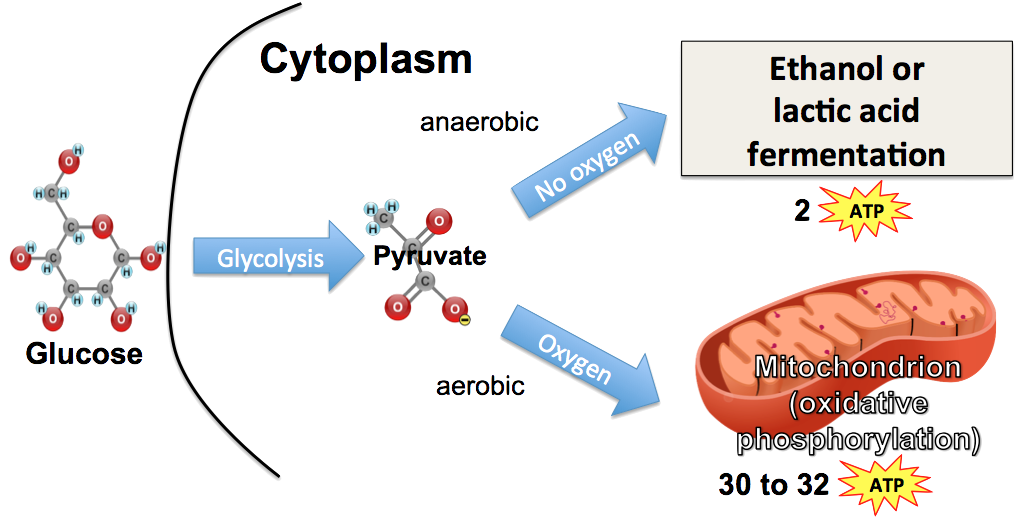
- Aerobic pathway: If oxygen is present, then aerobic respiration follows. Aerobic means “with oxygen.” Pyruvate will enter the cell’s mitochondria, where it will be totally oxidized in the Link Reaction and the Krebs cycle. This oxidation will power the reduction of the electron carriers NAD+ and FAD, which, as NADH and FADH2, will carry electrons to the electron transport chain, where they’ll power oxidative phosphorylation, creating lots of ATP for the cell.
- Anaerobic pathway: If oxygen is absent, then anaerobic respiration follows. Anaerobic respiration means “without oxygen.” Rather than being oxidized, pyruvate will be fermented. Fermentation doesn’t create additional energy for the cell, but it does regenerate NAD+, making it possible for the cell to continue carrying out glycolysis, which creates a small amount of ATP. Important food-related fermentations occur in yeast, which is used to produce the alcohol in beer or wine, or the bubbles of CO2 that occur when bread rises. Yogurt is another fermented product. Animals can also ferment pyruvic acid as part of anaerobic respiration, which occurs when our muscle cells become low in oxygen.
We’ll return to fermentation (and study it in more depth) at the end of this series on cellular respiration.
6. Glycolysis Fill-in-the-Blanks Quiz
[qwiz random = “true” qrecord_id=”sciencemusicvideosMeister1961-Glycolysis Fill-in-the-Blanks (M10)”]
[h]Glycolysis Fill-in-the-Blanks Quiz
[i]
[q][hangman] is the process that takes glucose and breaks it down in order to create NADH and ATP. It’s a series of reactions controlled by [hangman].
[c]R2x5Y29seXNpcw==[Qq]
[c]ZW56eW1lcw==[Qq]
[q]Glycolysis takes glucose and breaks it down to create NADH and [hangman].
[c]QVRQ[Qq]
[q]Glycolysis is an [hangman] metabolic pathway, meaning that it does not require oxygen.
[c]YW5hZXJvYmlj[Qq]
[q]The three phases of glycolysis are investment, [hangman], and energy harvest.
[c]Y2xlYXZhZ2U=[Qq]
[q]During the [hangman] phase of glycolysis, activation energy is supplied in the form of two phosphate groups supplied by two ATPs.
[c]aW52ZXN0bWVudA==[Qq]
[q]During the cleavage phase of glycolysis, a [hangman] carbon sugar is split into two.
[c]c2l4[Qq]
[q]During the investment phase of glycolysis, enzymes put two ATPs onto glucose, rearranging it into [hangman] 1- 6 bisphosphate
[c]ZnJ1Y3Rvc2U=[Qq]
[q]During the cleavage phase of glycolysis, [hangman] 1- 6 bisphosphate is split into two three-carbon molecules.
[c]RnJ1Y3Rvc2U=[Qq]
[q]The main product of cleavage is [hangman]-3-phosphate, also known as G3P
[c]Z2x5Y2VyYWxkZWh5aGRl[Qq]
[q]Cleavage results in the formation of [hangman] molecules of G3P.
[c]dHdv[Qq]
[q]During the harvest phase, each [hangman] provides the energy to power the creation of one NADH and 2 ATPs
[c]RzNQ[Qq]
[q]The [hangman] energy yield per molecule of glucose in glycolysis is two NADH and four ATPs. However, the [hangman] energy yield per molecule of glucose in glycolysis is two NADH and two ATPs
[c]Z3Jvc3M=[Qq]
[c]bmV0[Qq]
[q]By the end of glycolysis, glucose has been broken down into two molecules of [hangman] acid.
[c]cHlydXZpYw==[Qq]
[q]The [hangman] pathway that follows glycolysis is also known as fermentation. But if pyruvate is broken down [hangman], then it will proceed into the Krebs cycle and be completely oxidized.
[c]YW5hZXJvYmlj[Qq]
[c]YWVyb2JpY2FsbHk=[Qq]
[q]Glycolysis starts with the investment of two [hangman] to the glucose that starts the reaction.
[c]QVRQcw==[Qq]
[q]The main product of cleavage is glyceraldehyde-3-[hangman], also known as [hangman].
[c]cGhvc3BoYXRl[Qq]
[c]RzNQ[Qq]
[x]
[restart]
[/qwiz]
7. Glycolysis Interactive Lyrics
If you’ve listened to the song or sung it yourself (see my Glycolysis Karaoke Version), then working through these interactive lyrics might be the perfect way to consolidate your memory and understanding of glycolysis.
[qwiz qrecord_id=”sciencemusicvideosMeister1961-Glycolysis Interactive Lyrics (M10)”]
[h]Glycolysis Interactive Lyrics
[i]
[q labels = “top”]
__________ is a series of reactions,
Enzymatic actions, energy transactions,
Takes ________, a molecule so sugary,
Breaks it down for NADH and ______
It’s an __________ cytoplasmic pathway that amazes
Organized easily into three phases,
Investment, cleavage, and ________ harvest,
Tell me later which one you like best.
Investment: activation energy’s supplied,
_________: our six-carbon sugar divides
Harvest: we get our energy yield,
So beautiful, so intricate keep your eyes peeled
CHORUS
Glycolysis!
Come on sugar, come on sugar, for the breakdown. For the breakdown.
[l]anaerobic
[fx] No, that’s not correct. Please try again.
[f*] Good!
[l]ATP
[fx] No, that’s not correct. Please try again.
[f*] Great!
[l]cleavage
[fx] No, that’s not correct. Please try again.
[f*] Correct!
[l]energy
[fx] No, that’s not correct. Please try again.
[f*] Excellent!
[l]glucose
[fx] No, that’s not correct. Please try again.
[f*] Correct!
[l]glycolysis
[fx] No, that’s not correct. Please try again.
[f*] Excellent!
[q labels = “top”]
____________ like striking a match,
That energy you put in makes the fire catch
For glycolysis investments two ATPs,
Which act as __________ energy
Enzymes take __________ from ATPs
Jam ‘em on a glucose rearranging it to ________,
Leaving Fructose 1- 6 bisphosphate on the table,
With two phosphates, it’s highly unstable!
[l]activation
[fx] No. Please try again.
[f*] Good!
[l]fructose
[fx] No. Please try again.
[f*] Good!
[l]investment’s
[fx] No. Please try again.
[f*] Great!
[l]phosphate
[fx] No. Please try again.
[f*] Good!
[q labels = “top”]
Moving us to the second phase
The cleaving of Fructose _____________
Cause glycolysis means ________ sugar, you can see
cleavage yields two molecules with carbons _______
One is ______________ 3 phosphate G3P
It continues on our pathway broken down for energy
But the second one an enzyme will immediately,
Convert into a second _____
CHORUS
[l]bisphosphate
[fx] No. Please try again.
[f*] Good!
[l]glyceraldehyde
[fx] No, that’s not correct. Please try again.
[f*] Great!
[l]splitting
[fx] No. Please try again.
[f*] Correct!
[l]three
[fx] No, that’s not correct. Please try again.
[f*] Correct!
[l]G3P
[fx] No. Please try again.
[f*] Good!
[q labels = “top”]
Phase 3: ______ gets rearranged and ________,
By an enzymatic assembly line,
That harvest energy from each G3P
One ________ and 2 ATPs
Double this yield per G3P
To two NADH and _____ ATPs
That’s the gross yield for every ________ in
A generous accounting of glycolysis’s win
[l]4
[fx] No. Please try again.
[f*] Great!
[l]G3P
[fx] No, that’s not correct. Please try again.
[f*] Correct!
[l]glucose
[fx] No. Please try again.
[f*] Good!
[l]NADH
[fx] No, that’s not correct. Please try again.
[f*] Great!
[l]oxidized
[fx] No, that’s not correct. Please try again.
[f*] Excellent!
[q labels = “top”]
But 2 ______ were invested in phase 1
So you net just two you can use to jump or run,
Put two in, get four out, your net gain is ______,
Two ATPs that you can use.
If that doesn’t seem like very much, it’s cause it ain’t,
There’s tons of energy left in _________,
The two _______ carbon molecules we’re left with at the end.
And what happens to pyruvate is gonna depend,
On the metabolic pathway where pyruvate gets sent,
If its anaerobic it’ll be __________
But in aerobic cells pyruvate’s termination
Will be the Krebs cycle and total _________!
CHORUS
[l]ATPs
[fx] No, that’s not correct. Please try again.
[f*] Great!
[l]fermented
[fx] No. Please try again.
[f*] Correct!
[l]oxidation
[fx] No, that’s not correct. Please try again.
[f*] Great!
[l]pyruvate
[fx] No, that’s not correct. Please try again.
[f*] Great!
[l]three
[fx] No, that’s not correct. Please try again.
[f*] Great!
[l]two
[fx] No, that’s not correct. Please try again.
[f*] Great!
[q labels = “top”]
Review: glycolysis starts with __________
of two ATPs to the ________ that we started with,
The product is cleaved into two ______
From which the cell harvests ______ and ______.
This anaerobic pathway is ____________ first phase,
It’s billions of year’s old evolved in ancient days
before O2 accumulated in the seas, before
eukaryotic cells like ours arrived on the scene
It’s everywhere, ubiquitous, in every organism,
Bacteria, sequoia tree, no matter your metabolism,
Happens in the __________ doesn’t need no organelles.
You wanna find glycolysis? Look in any cell!
[l]ATPs
[fx] No. Please try again.
[f*] Good!
[l]cytoplasm
[fx] No, that’s not correct. Please try again.
[f*] Good!
[l]G3Ps
[fx] No, that’s not correct. Please try again.
[f*] Correct!
[l]glucose
[fx] No, that’s not correct. Please try again.
[f*] Excellent!
[l]investment
[fx] No. Please try again.
[f*] Correct!
[l]NADH
[fx] No, that’s not correct. Please try again.
[f*] Good!
[l]respiration’s
[fx] No, that’s not correct. Please try again.
[f*] Excellent!
[x]
[restart]
[/qwiz]
Links
- The Krebs Cycle and the Link Reaction (the next tutorial in this series)
- Cellular Respiration Main menu
